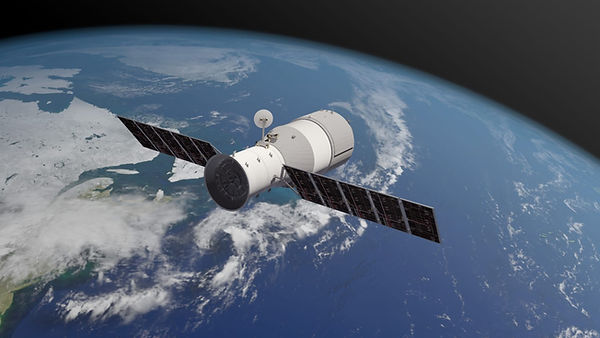
Space Ballsup

It's Easter, and I’m really looking forward to relaxing with some chocolate eggs this weekend. But come Monday, we might have something wild happening: a space station could actually crash through my roof!
That’s right, the Tiangong-1 is on its way down and is expected to land on April 1st, somewhere between here and Nebraska. Drive safely this weekend!
Launched back in 2011, Tiangong-1 was supposed to be the start of a bigger space station. It served as a docking port for a multi-module setup and helped test some docking systems. But after losing communication in 2016, it’s just been floating around as space junk. Now, it’s basically a chunk of molten metal speeding toward Earth, with a path that spans from 42.7 degrees north to 42.7 degrees south. And who knows, it could come crashing down right through your roof!
Officials say there’s really no need to freak out about debris from Tiangong-1. “It won’t crash to Earth like those crazy sci-fi movies; it’ll just be more like a meteor shower,” they said.
I’m just going to stay indoors! And for those of you who want to check it out, keep your eyes on the sky tonight—you might see it breaking apart up there, looking like a cool meteor shower!
Mars One

When I think of Mars, I envision Martians like Fleebak—quirky little green beings in gleaming, saucer-shaped spacecraft, darting across the cosmos like flashes of light.
NASA, along with several pioneering corporations, is embarking on an exhilarating mission to Mars, and yes, that’s right—Mars! This ambitious endeavour, known as Mars One, is set to launch within the next decade, with the first crewed spacecraft poised to reach the crimson planet in 2024. The journey promises to be a remarkable adventure, taking approximately 260 days through the vastness of space.
So, why Mars? Humanity is preparing to embark on an extraordinary journey to colonise other planets and moons as our population continues to grow at an astonishing rate. Mars, with its deep red surface and tantalising mysteries, stands as one of our closest neighbouring worlds.
Soon, we will leap through the solar system like audacious explorers, expanding our presence among the stars. Our aspirations stretch even further into the depths of the universe; while such ventures may not unfold in my lifetime, I am confident that our great-great-grandchildren will stand witness to that awe-inspiring day.
Astroid Solutions

What if meteors or asteroids weren't ominous threats to humanity but rather incredible opportunities waiting to be harnessed? What if we could extract invaluable minerals from these distant celestial bodies? This captivating concept, known as terrestrial mining, holds the promise of transforming our relationship with resources.
Asteroids and meteors sparkle with riches like gold, silver, tungsten, iron, titanium, and an array of rare minerals that are increasingly hard to find on Earth. As terrestrial resources dwindle, the notion of venturing into the cosmos to harvest these treasures is not just a whimsical dream; it is a visionary path to a brighter, sustainable future.
We have already embarked on a remarkable journey by launching an orbiter to scan the Moon for helium-3, a precious element poised to fuel the fusion reactors of tomorrow, thanks to the groundbreaking efforts of the Chinese Lunar Exploration Program.
For years, scientists have sounded alarms about the potential devastation of a meteor strike threatening life as we know it. Yet, today, their focus is shifting toward these celestial beings as extraordinary sources of untapped wealth, igniting ambitious plans to capture asteroids with sophisticated spacecraft and guide them gracefully into orbit around our planet. Imagine the profound possibilities of collecting these asteroids and presenting them as coveted assets to the highest bidder.
The horizon of our future is rich with potential, and we stand on the threshold of an exhilarating journey. Personally, I find myself brimming with anticipation for the Mars missions, eager to witness the unfolding of these groundbreaking explorations.
Nanorobotics

Molecular machines, often referred to as nanobots, are intricately crafted at an astonishingly small scale of nanometers.
These extraordinary creations, composed of meticulously engineered nanoscale components, are almost imperceptible to the naked eye. While they remain in the developmental phase, the promise they hold is revolutionary: these tiny titans could target and obliterate cancer cells, detect hazardous toxins, and facilitate precise movements under the lens of a microscope.
Envision a future where nanobots gracefully navigate through our bodies, swiftly mending injuries and battling diseases. These miniature wonders could seek out and dismantle harmful cells, remove damaged tissue, or even restore a failing heart—all while we relax, perhaps napping peacefully or enjoying a favourite show. Delivered in pill form, they could seamlessly integrate into our systems, exiting quietly when no longer needed.
Though still on the drawing board, the arrival of nanobot technology is fast approaching, heralding a new chapter in medicine filled with hope and boundless innovation. Let's embrace the exciting possibilities that await us!
Space X

Elon Musk has made history with the launch of the Falcon Heavy, the largest operational rocket in the world! Weighing in at just over 64 metric tonnes—about the size of a Boeing 737—this giant rocket packs a serious punch. At liftoff, it generates a whopping five million pounds of thrust, which is absolutely incredible!
What’s really cool about the Falcon Heavy is its first stage, which features nine powerful engine cores, all powered by 27 Merlin engines. Together, these engines produce an astonishing 2,267 tonnes of thrust—imagine that’s like having the power of eighteen 747 passenger planes lifting off at the same time! Not only is it a marvel of engineering, but the Falcon Heavy can carry an impressive payload of up to 16,800 kg to Mars!
It’s built on the foundation of SpaceX's earlier Falcon 9 rocket, but it’s way bigger and stronger. This remarkable rocket was designed for exciting missions, like transporting passengers and cargo to the Moon and Mars, opening up a whole new world for space exploration. Isn’t that amazing?